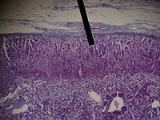
Zona glomerulosa
Encyclopedia
The zona glomerulosa of the adrenal gland
is the most superficial layer of the adrenal cortex, lying directly beneath the adrenal gland's capsule. Its cells are ovoid in shape and are arranged in clusters or arches (glomus is Latin for "ball").
In response to increased potassium
levels, renin
or decreased blood flow to the kidneys, cells of the zona glomerulosa produce and secrete the mineralocorticoid aldosterone
into the blood as part of the renin-angiotensin system
. Aldosterone regulates the body's concentration of electrolyte
s, primarily sodium
and potassium, by acting on the distal convoluted tubule
of kidney nephron
s to:
The enzyme aldosterone synthase
acts in this location.
.jpg)
Adrenal gland
In mammals, the adrenal glands are endocrine glands that sit atop the kidneys; in humans, the right suprarenal gland is triangular shaped, while the left suprarenal gland is semilunar shaped...
is the most superficial layer of the adrenal cortex, lying directly beneath the adrenal gland's capsule. Its cells are ovoid in shape and are arranged in clusters or arches (glomus is Latin for "ball").
In response to increased potassium
Potassium
Potassium is the chemical element with the symbol K and atomic number 19. Elemental potassium is a soft silvery-white alkali metal that oxidizes rapidly in air and is very reactive with water, generating sufficient heat to ignite the hydrogen emitted in the reaction.Potassium and sodium are...
levels, renin
Renin
Renin , also known as an angiotensinogenase, is an enzyme that participates in the body's renin-angiotensin system -- also known as the Renin-Angiotensin-Aldosterone Axis -- that mediates extracellular volume , and arterial vasoconstriction...
or decreased blood flow to the kidneys, cells of the zona glomerulosa produce and secrete the mineralocorticoid aldosterone
Aldosterone
Aldosterone is a hormone that increases the reabsorption of sodium ions and water and the release of potassium in the collecting ducts and distal convoluted tubule of the kidneys' functional unit, the nephron. This increases blood volume and, therefore, increases blood pressure. Drugs that...
into the blood as part of the renin-angiotensin system
Renin-angiotensin system
The renin-angiotensin system or the renin-angiotensin-aldosterone system is a hormone system that regulates blood pressure and water balance....
. Aldosterone regulates the body's concentration of electrolyte
Electrolyte
In chemistry, an electrolyte is any substance containing free ions that make the substance electrically conductive. The most typical electrolyte is an ionic solution, but molten electrolytes and solid electrolytes are also possible....
s, primarily sodium
Sodium
Sodium is a chemical element with the symbol Na and atomic number 11. It is a soft, silvery-white, highly reactive metal and is a member of the alkali metals; its only stable isotope is 23Na. It is an abundant element that exists in numerous minerals, most commonly as sodium chloride...
and potassium, by acting on the distal convoluted tubule
Distal convoluted tubule
The distal convoluted tubule is a portion of kidney nephron between the loop of Henle and the collecting duct system.- Physiology :It is partly responsible for the regulation of potassium, sodium, calcium, and pH...
of kidney nephron
Nephron
The renal tubule is the portion of the nephron containing the tubular fluid filtered through the glomerulus. After passing through the renal tubule, the filtrate continues to the collecting duct system, which is not part of the nephron....
s to:
- increase sodium reabsorption
- increase potassium excretionExcretionExcretion is the process by which waste products of metabolism and other non-useful materials are eliminated from an organism. This is primarily carried out by the lungs, kidneys and skin. This is in contrast with secretion, where the substance may have specific tasks after leaving the cell...
- increase water reabsorption through osmosisOsmosisOsmosis is the movement of solvent molecules through a selectively permeable membrane into a region of higher solute concentration, aiming to equalize the solute concentrations on the two sides...
The enzyme aldosterone synthase
Aldosterone synthase
Aldosterone synthase is a steroid hydroxylase cytochrome P450 oxidase enzyme involved in the generation of aldosterone....
acts in this location.
.jpg)

